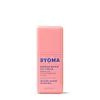What's inside
What's inside
 Key Ingredients
Key Ingredients

 Benefits
Benefits

 Concerns
Concerns

 Ingredients Side-by-side
Ingredients Side-by-side

Water
Skin ConditioningButyrospermum Parkii Butter
Skin ConditioningGlycerin
HumectantHelianthus Annuus Seed Oil
EmollientVitis Vinifera Seed Oil
EmollientCoffea Arabica Seed Extract
MaskingCucumis Sativus Fruit Extract
EmollientC14-22 Alcohols
Emulsion StabilisingC12-20 Alkyl Glucoside
EmulsifyingOlea Europaea Fruit Oil
MaskingSodium Hyaluronate
HumectantAcer Rubrum Extract
Skin ConditioningTocopherol
AntioxidantRosmarinus Officinalis Leaf Extract
AntimicrobialAnthemis Nobilis Flower Oil
MaskingCalendula Officinalis Extract
Skin ConditioningXanthan Gum
EmulsifyingSalicylic Acid
MaskingGlucose
HumectantSorbic Acid
PreservativeCitric Acid
BufferingSodium Benzoate
MaskingPotassium Sorbate
PreservativeBenzyl Alcohol
PerfumingLimonene
PerfumingLinalool
PerfumingWater, Butyrospermum Parkii Butter, Glycerin, Helianthus Annuus Seed Oil, Vitis Vinifera Seed Oil, Coffea Arabica Seed Extract, Cucumis Sativus Fruit Extract, C14-22 Alcohols, C12-20 Alkyl Glucoside, Olea Europaea Fruit Oil, Sodium Hyaluronate, Acer Rubrum Extract, Tocopherol, Rosmarinus Officinalis Leaf Extract, Anthemis Nobilis Flower Oil, Calendula Officinalis Extract, Xanthan Gum, Salicylic Acid, Glucose, Sorbic Acid, Citric Acid, Sodium Benzoate, Potassium Sorbate, Benzyl Alcohol, Limonene, Linalool
Water
Skin ConditioningGlycerin
HumectantCaprylic/Capric Triglyceride
MaskingPhenyl Trimethicone
Skin ConditioningCetyl Ethylhexanoate
EmollientHyaluronic Acid
HumectantHydrolyzed Hyaluronic Acid
HumectantSodium Hyaluronate
HumectantPropanediol
SolventCopper Tripeptide-1
Skin ConditioningButyrospermum Parkii Butter
Skin ConditioningSphingolipids
EmollientEthylhexylglycerin
Skin ConditioningCeramide NP
Skin ConditioningDipropylene Glycol
HumectantButylene Glycol
HumectantCaprylic/Capric/Succinic Triglyceride
EmollientVinyldimethicone
Acrylates/C10-30 Alkyl Acrylate Crosspolymer
Emulsion StabilisingXanthan Gum
EmulsifyingPolyglyceryl-2 Stearate
EmulsifyingGlyceryl Stearate
EmollientStearyl Alcohol
EmollientGlycereth-26
HumectantCetearyl Alcohol
EmollientEctoin
Skin Conditioning1,2-Hexanediol
Skin ConditioningGlycine
BufferingTheobroma Cacao Seed Extract
AntioxidantThamnolia Vermicularis Leaf Extract
Skin ConditioningCoptis Japonica Root Extract
Skin ConditioningHydroxyacetophenone
AntioxidantAmmonium Polyacryloyldimethyl Taurate
Emulsion StabilisingDextrin
AbsorbentTromethamine
BufferingDisodium EDTA
Water, Glycerin, Caprylic/Capric Triglyceride, Phenyl Trimethicone, Cetyl Ethylhexanoate, Hyaluronic Acid, Hydrolyzed Hyaluronic Acid, Sodium Hyaluronate, Propanediol, Copper Tripeptide-1, Butyrospermum Parkii Butter, Sphingolipids, Ethylhexylglycerin, Ceramide NP, Dipropylene Glycol, Butylene Glycol, Caprylic/Capric/Succinic Triglyceride, Vinyldimethicone, Acrylates/C10-30 Alkyl Acrylate Crosspolymer, Xanthan Gum, Polyglyceryl-2 Stearate, Glyceryl Stearate, Stearyl Alcohol, Glycereth-26, Cetearyl Alcohol, Ectoin, 1,2-Hexanediol, Glycine, Theobroma Cacao Seed Extract, Thamnolia Vermicularis Leaf Extract, Coptis Japonica Root Extract, Hydroxyacetophenone, Ammonium Polyacryloyldimethyl Taurate, Dextrin, Tromethamine, Disodium EDTA
 Reviews
Reviews

Ingredients Explained
These ingredients are found in both products.
Ingredients higher up in an ingredient list are typically present in a larger amount.
This ingredient is also known as shea butter. It is an effective skin hydrator and emollient.
Emollients help soothe and soften your skin. It does this by creating a protective film on your skin. This barrier helps trap moisture and keeps your skin hydrated. Emollients may be effective at treating dry or itchy skin.
Shea butter is rich in antioxidants. Antioxidants help fight free-radicals, or molecules that may harm the body. It is also full of fatty acids including stearic acid and linoleic acid. These acids help replenish the skin and keep skin moisturized.
While Shea Butter has an SPF rating of about 3-4, it is not a sunscreen replacement.
Shea butter may not be fungal acne safe. We recommend speaking with a professional if you have any concerns.
Learn more about Butyrospermum Parkii ButterGlycerin is already naturally found in your skin. It helps moisturize and protect your skin.
A study from 2016 found glycerin to be more effective as a humectant than AHAs and hyaluronic acid.
As a humectant, it helps the skin stay hydrated by pulling moisture to your skin. The low molecular weight of glycerin allows it to pull moisture into the deeper layers of your skin.
Hydrated skin improves your skin barrier; Your skin barrier helps protect against irritants and bacteria.
Glycerin has also been found to have antimicrobial and antiviral properties. Due to these properties, glycerin is often used in wound and burn treatments.
In cosmetics, glycerin is usually derived from plants such as soybean or palm. However, it can also be sourced from animals, such as tallow or animal fat.
This ingredient is organic, colorless, odorless, and non-toxic.
Glycerin is the name for this ingredient in American English. British English uses Glycerol/Glycerine.
Learn more about GlycerinSodium Hyaluronate is hyaluronic acid's salt form. It is commonly derived from the sodium salt of hyaluronic acid.
Like hyaluronic acid, it is great at holding water and acts as a humectant. This makes it a great skin hydrating ingredient.
Sodium Hyaluronate is naturally occurring in our bodies and is mostly found in eye fluid and joints.
These are some other common types of Hyaluronic Acid:
Learn more about Sodium HyaluronateWater. It's the most common cosmetic ingredient of all. You'll usually see it at the top of ingredient lists, meaning that it makes up the largest part of the product.
So why is it so popular? Water most often acts as a solvent - this means that it helps dissolve other ingredients into the formulation.
You'll also recognize water as that liquid we all need to stay alive. If you see this, drink a glass of water. Stay hydrated!
Learn more about WaterXanthan gum is used as a stabilizer and thickener within cosmetic products. It helps give products a sticky, thick feeling - preventing them from being too runny.
On the technical side of things, xanthan gum is a polysaccharide - a combination consisting of multiple sugar molecules bonded together.
Xanthan gum is a pretty common and great ingredient. It is a natural, non-toxic, non-irritating ingredient that is also commonly used in food products.
Learn more about Xanthan Gum